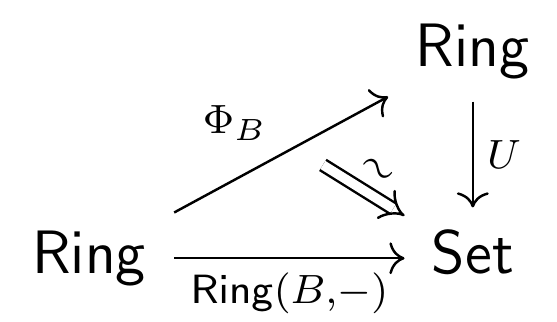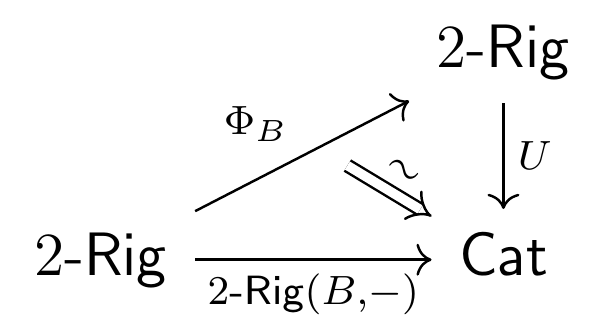Schur Functors and Categorified Plethysm
Posted by John Baez
It’s done!
- John Baez, Joe Moeller and Todd Trimble, Schur functors and categorified plethysm.
This paper has been 14 years in the making. So let me tell you a bit of its history, and then I’ll explain the paper itself.
The history
This paper got its start in April 2007 when Allen Knutson raised a question about Schur functors here on the -Category Café. I conjectured an answer, and later Todd Trimble refined the conjecture and proved it. We had this written up on the nLab by July 2010. At this point we knew exactly why the category of Schur functors is a categorified version of , the polynomials in one variable.
Then came a long pause. I went to Singapore for 2 years and started work on applied category theory. When I came back to California, I worked with grad students only on that subject.
In 2015 Joe Moeller became a grad student at U. C. Riverside. He did applied category theory, but he had a strong interest in pure math, so after his thesis was mostly done we decided to start a side-project on representation theory. We knew that the Grothendieck group of the category of Schur functors is the ring of symmetric functions. This ring has a lot of structure: like , it’s something called a plethory. It seemed clear that most of this structure comes from the category of Schur functors, which should thus be some sort of categorified plethory. We began to work out the details around February 2020.
Todd Trimble rejoined the project roughly around June of that year. Since then he’s been the idea engine, pushing the paper to completion. This paper is the result.
Schur functors and categorified plethysm
The symmetric groups play a distinguished role in group theory, and their representations are rich in structure. Much of this structure only reveals itself if we collect all these groups into the groupoid of finite sets and bijections. Let be the category of finite-dimensional vector spaces over a field of characteristic zero. A functor simply amounts to a (possibly infinite) direct sum of representations of the groups . Our focus is on , the full subcategory of consisting of finite direct sums of finite-dimensional representations.
This category binds all the finite-dimensional representations of all the symmetric groups into a single entity, revealing more structure than can be seen working with these groups one at a time. In particular, has a monoidal structure called the ‘plethysm’ tensor product, with respect to which acts on the category of representations of any group . Each object of acts as an endofunctor of called a ‘Schur functor’. Thus, plays a fundamental role in representation theory, which we aim to clarify.
We also apply our results on to study the ring of symmetric functions, denoted . This ring shows up in many guises throughout mathematics. For example:
It is the Grothendieck group of the category .
It is the subring of consisting of power series of bounded degree that are invariant under all permutations of the variables — hence the name symmetric functions.
It is the cohomology ring , where is the classifying space of the infinite-dimensional unitary group.
As a mere ring, is not very exciting: it is isomorphic to a polynomial ring in countably many generators. But is richly endowed with a plethora of further structure. In his excellent review article, Hazewinkel gushed:
It seems unlikely that there is any object in mathematics richer and/or more beautiful than this one [….]
Following ideas of Tall and Wraith, Borger and Wieland defined a concept of ‘plethory’ (which we call ‘ring-plethory’) that encapsulates much of this rich structure on . Here we derive the ring-plethory structure on from a ‘2-plethory’ structure on , of which is the Grothendieck group. More than merely proving that is a ring-plethory, this shows that much of its rich structure exists at a higher level in the category of Schur functors.
What is a ring-plethory? To understand this, it is good to start with the simplest example of all, , the ring of polynomials with integer coefficients in one variable. (Following the algebraic geometers, we use ‘ring’ to mean ‘commutative ring with unit’.) is the free ring on one generator. But besides the usual ring operations, also has ‘co-operations’ that act like ring operations going backwards. These are all derived by exploiting the freeness property. Namely, is equipped with the unique ring homomorphisms that send to the indicated elements:
coaddition:
co-zero:
co-negation:
comultiplication:
co-one:
These obey all the usual ring axioms if we regard them as morphisms in the opposite of the category of rings. Thus we say is a biring: a ring object in .
Why is a biring? Any ring can be seen as the ring of functions on some kind of space, and is the ring of functions on the affine line, . Grothendieck made this into a tautology by defining the category of affine schemes to be and defining to be the ring seen as an object in . But the affine line itself can be made into a ring, much like the real or complex line. Thus becomes a ring object in the category of affine schemes. But this is precisely a biring! The formulas above express the ring operations on as co-operations on .
A biring can equivalently be seen as a ring such that the representable functor
is equipped with a lift to a functor taking values in the category of rings, like this:

Given a biring , the co-operations on give a ring structure for any ring in a way that depends functorially on . For example, since is the free ring on one generator, assigns to any ring its underlying set. Thus lifts to the identity functor on . This gives a natural biring structure, and one can check that this is the one described above.
This second viewpoint is fruitful because endofunctors on can be composed. Though not all endofunctors on are representable, those that are representable are closed under composition. Thus for any birings and there is a biring such that
This puts a monoidal structure on the category , called the composition tensor product. A ring-plethory is then a monoid object in . Since the category is defined as the opposite of the category of ring objects in , is a ring-plethory when is a comonad.
For example, since lifts to the identity functor on , and the identity functor is a comonad, with the resulting biring structure is a ring-plethory. Concretely, this ring-plethory structure on simply captures the fact that one can compose polynomials in one variable.
A more interesting ring-plethory is , the ring of symmetric functions. This structure is often described in terms of fairly elaborate algebraic constructions. It seems not to be generally appreciated that there is a conceptual explanation for all this structure. Our goal is to provide that explanation.
We achieve this by categorifying the story so far, developing a theory of 2-plethories, and showing that is a 2-plethory. Using this fact we show that , the Grothendieck group of , is a ring-plethory.
Before doing this, we must categorify the concepts of ring and biring. Or rather, since it is problematic to categorify subtraction directly, we start by omitting additive inverses and work not with rings but with rigs, which again we assume to be commutative. A birig is then a rig object in the opposite of the category of rigs. For example, the free rig on one generator is , and this becomes a birig with co-operations defined just as for above — except for co-negation.
The concept of plethory also generalizes straightforwardly from rings to rigs. In fact it generalizes to algebras of any monad on . Stacey and Whitehouse called such a generalized plethory a ‘Tall–Wraith monoid’, but we prefer to call it an M-plethory in order to refer to various specific monads . If is the monad whose algebras are rings, then -plethories are ring-plethories, but when is the monad for rigs, we call an -plethory a rig-plethory. For example, just as becomes a ring-plethory, becomes a rig-plethory. This captures the fact that we can compose polynomials in .
There are various ways to categorify the concept of rig. Since our goal is to study Schur functors and some related classical topics in representation theory, we shall fix a field of characteristic zero and define — just for the purposes of this paper — a ‘2-rig’ to be a symmetric monoidal Cauchy complete linear category. In more detail:
A linear category is an essentially small category enriched over , the category of vector spaces over .
A linear category is Cauchy complete when it has biproducts and all idempotents split.
A symmetric monoidal linear category is a linear category with a symmetric monoidal structure for which the tensor product is bilinear on hom-spaces.
A 2-rig is a symmetric monoidal linear category that is also Cauchy complete.
In language perhaps more familiar to algebraists, a linear category is Cauchy complete when it has finite direct sums and any idempotent endomorphism has a cokernel. In this definition of 2-rig we do not need to impose a rule saying that the tensor product preserves biproducts and splittings of idempotents in each argument, since this is automatic: these are ‘absolute’ colimits for linear categories, meaning they are preserved by any linear functor. This absoluteness is one of the virtues of demanding only Cauchy completeness rather a larger class of colimits.
With this definition, turns out to be the free 2-rig on one generator. Many other important categories are also 2-rigs:
- the category of finite-dimensional vector spaces over ,
- the category of representations of any group on finite-dimensional vector spaces,
- the category of finite-dimensional -graded vector spaces for any group ,
- the category of bounded chain complexes of finite-dimensional vector spaces,
- the category of finite-dimensional super vector spaces,
- for or , the category of finite-dimensional vector bundles over any topological space, or smooth vector bundles over any smooth manifold,
- the category of algebraic vector bundles over any algebraic variety over ,
- the category of coherent sheaves of finite-dimensional vector spaces over any algebraic variety (or scheme or algebraic stack) over .
Some of these categories are abelian, but categories of vector bundles are typically not. They are still Cauchy complete, and this is another reason we develop our theory at this level of generality.
There is a 2-category of 2-rigs, denoted , and we define a 2-birig to be a 2-rig such that the 2-functor is equipped with a lift to a 2-functor taking values in 2-rigs:

There is a 2-category of 2-birigs. Analogously with birings, for any 2-birigs and there is a 2-birig corresponding to endofunctor composition. This equips the 2-category with a monoidal structure. We define a 2-plethory to be a pseudomonoid — roughly, a monoid object up to coherent isomorphism — in . The multiplication in this pseudomonoid is called the plethysm tensor product.
Just as is the free rig on one generator, we prove that is the free 2-rig on one generator. It follows that lifts to the identity 2-functor on :

This makes into a 2-birig, and indeed a 2-plethory. This captures the fact that we can compose Schur functors.
Taking the Grothendieck group of , we obtain the known ring-plethory structure on , the ring of symmetric functions. The birig structure is fairly straightforward. The rig-plethory structure takes considerably more work. Most subtle of all is the biring structure, and in particular the co-negation, which involves -graded chain complexes of Schur functors and their Euler characteristic. This is connected to the ‘rule of signs’ in Joyal’s theory of species.
Outline of the paper
The paper is long, because there’s more to it than described above, and we try to explain everything in a gentle manner. Here’s how it goes.
Section 2 begins with an overview of the classical theory of Schur functors in representation theory, as well as their relation to finite-dimensional linear species, which we call polynomial species. The rest of this section builds up to our abstract definition of Schur functors as endomorphisms of the forgetful 2-functor .
Our first main result, Theorem 3.1, is that the category of abstract Schur functors is equivalent to the category of polynomial species. Section 3 is dedicated to proving this. En route, we prove in Theorems 3.2 and 3.2 that is the underlying category of the free 2-rig on one generator, and that this 2-rig represents the 2-functor .
In Section 4 we define 2-birigs, a categorification of the notion of biring. In Theorem 4.4 we show that has a 2-birig structure coming from its equivalence with the free 2-rig on one generator.
In Section 5, we begin by exposing an alternative perspective on birigs. Birigs and birings are examples of the more general notion of -bialgebras: that is, bialgebras of a monad on . Moreover, the category of -bialgebras admits a substitution (non-symmetric) monoidal structure. This allows us to define -plethories as monoids with respect to this monoidal structure. Then we use this perspective to categorify the notion of rig-plethory, obtaining the concept of 2-plethory. In Theorem 5.15 we give the structure of a 2-plethory.
In Section 6 we begin the decategorification process by studying the rig of isomorphism classes of objects in . We denote this rig by , and call its elements positive symmetric functions, since it is a sub-rig of the famous ring of symmetric functions, . In Theorem 6.7 we equip with a birig structure using the 2-birig structure on , and in Theorem 6.12 we equip with a rig-plethory structure using the 2-plethory structure on .
In Section 7 we study the group completion of , which is . This is evidently a ring, but making it into a biring is less straightforward: to define co-negation in this biring and prove its properties we need the homology of -graded chain complexes of Schur functors. Co-negation then involves a grading shift — a trick one often sees in categorification these days. We make into a biring in Theorem 7.12, and make it into a ring-plethory in Theorem 7.13.


Re: Schur Functors and Categorified Plethysm
Special you’re welcome! BTW this ring is also the free lambda-ring on one generator, the main theorem of Knutson’s* book “Lambda-rings and the representation theory of the symmetric group”.
*my father